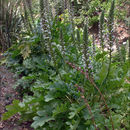Brief Summary
provided by EOL authors
Bear's breeches (Acanthus mollis) is a very ornamental herbaceous perennial with large shiny dark green leaves. The plant grows in a clump about 5' (1.5 m) tall, with slightly less spread. The leaves can be up to 3 ft (1 m) long, with deep cuts, although there's quite a bit of variation among individual leaves. Each lobe is tipped with a soft (not sharp) spine. In late summer, bear's breeches blooms with creamy white to slightly pink or purplish flowers on dramatically tall, erect stalks held way above the foliage. Acanthus mollis is native to the Mediterranean region of northern Africa and southwestern Europe.
Culture
provided by EOL authors
Bear's breeches performs best in loose, average to rich soil. It tolerates moderately dry conditions once established. Light: Bear's breeches can be grown in full sun to partial shade. Moisture: Bear's breeches does not tolerate constantly wet soil. Grow this perennial in well drained, but moist soil. Hardiness: USDA Zones 7-10. Propagation: Propagate with 2-3 in (5-8 cm) root cuttings taken in spring. Fresh seed will germinate in a month or so.
Usage
provided by EOL authors
Acanthus mollis stands out in a bed of ferns or hostas, providing contrast with its darker color, greater size, and complex texture. It is a stately specimen in a courtyard garden. Some of the dignity that seems inherent in this plant might stem from its use in the ornamentation of classical Greek artwork and Corinthian columns! Probably because of its classical background, or perhaps because of the sculptural nature of the plant, it imposes an air of formality. With bold textured large leaves, and a tall, imposing flower spike, bear's breeches makes a fine specimen planting in a mixed border or in a stand alone grouping of 3 to 5 plants. Beware, though - It will continue to expand and invade its surrounding area, and every little piece of root that gets broken off is likely to start a new plant.

